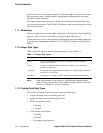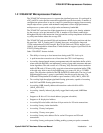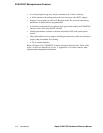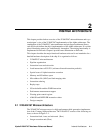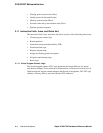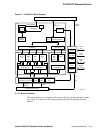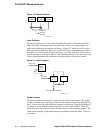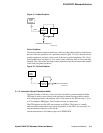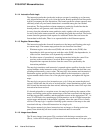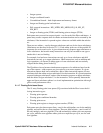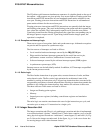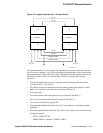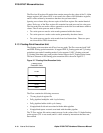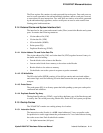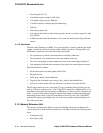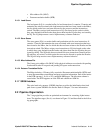2–6 Internal Architecture
Alpha 21264/EV67 Hardware Reference Manual
21264/EV67 Microarchitecture
2.1.1.4 Instruction Fetch Logic
The instruction prefetcher (predecode) reads an octaword, containing up to four natu-
rally aligned instructions per cycle, from the Icache. Branch prediction and line predic-
tion bits accompany the four instructions. The branch prediction scheme operates most
efficiently when only one branch instruction is contained among the four fetched
instructions. The line prediction scheme attempts to predict the Icache line that the
branch predictor will generate, and is described in Section 2.2.
An entry from the subroutine return prediction stack, together with set prediction bits
for use by the Icache stream controller, are fetched along with the octaword. The Icache
stream controller generates fetch requests for additional Icache lines and stores the
Istream data in the Icache. There is no separate buffer to hold Istream requests.
2.1.1.5 Register Rename Maps
The instruction prefetcher forwards instructions to the integer and floating-point regis-
ter rename maps. The rename maps perform the two functions listed here:
• Eliminate register write-after-read (WAR) and write-after-write (WAW) data
dependencies while preserving true read-after-write (RAW) data dependencies, in
order to allow instructions to be dynamically rescheduled.
• Provide a means of speculatively executing instructions before the control flow
previous to those instructions is resolved. Both exceptions and branch
mispredictions represent deviations from the control flow predicted by the
instruction prefetcher.
The map logic translates each instruction’s operand register specifiers from the virtual
register numbers in the instruction to the physical register numbers that hold the corre-
sponding architecturally-correct values. The map logic also renames each instruction’s
destination register specifier from the virtual number in the instruction to a physical
register number chosen from a list of free physical registers, and updates the register
maps.
The map logic can process four instructions per cycle. It does not return the physical
register, which holds the old value of an instruction’s virtual destination register, to the
free list until the instruction has been retired, indicating that the control flow up to that
instruction has been resolved.
If a branch mispredict or exception occurs, the map logic backs up the contents of the
integer and floating-point register rename maps to the state associated with the instruc-
tion that triggered the condition, and the prefetcher restarts at the appropriate VPC. At
most, 20 valid fetch slots containing up to 80 instructions can be in flight between the
register maps and the end of the machine’s pipeline, where the control flow is finally
resolved. The map logic is capable of backing up the contents of the maps to the state
associated with any of these 80 instructions in a single cycle.
The register rename logic places instructions into an integer or floating-point issue
queue, from which they are later issued to functional units for execution.
2.1.1.6 Integer Issue Queue
The 20-entry integer issue queue (IQ), associated with the integer execution units
(Ebox), issues the following types of instructions at a maximum rate of four per cycle:



